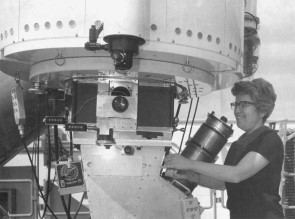What is dark matter?
Dark matter is an unknown collection of particles that cosmologists believe contribute to the gravitational field of the Universe, and out-weigh normal matter by around five to one. The existence of dark matter has been suspected since the first half of the twentieth century.
The first evidence comes in the 1930s when Swiss-American astronomer Fritz Zwicky measured the speed at which galaxies are moving in the Coma Cluster. He found they are travelling much faster than expected from the amount of visible matter in the cluster.
 |
| Vera Rubin at Kitt Peak National Observatory. Credit: NOAO/AURA/NSF |
In the 1970s, American astronomer Vera Rubin discovered that the outer regions of individual galaxies were rotating much faster than expected. It too seemed to indicate that there was more matter contributing to the galaxy's gravity than could be seen.
In 1974, American physicist James Peebles led a study into the true mass of galaxies and found that an estimate based on how much matter could be seen as stars was lower than an estimate based on a galaxy's movements by a factor of about ten. So for every kilogram of visible matter, which we can see because it emits light, there appeared to be at least ten kilograms of invisible or 'dark' matter. The team also showed that this was consistent with the measurements of galaxy clusters, and so these problems were linked.
Initially this 'dark matter' was thought to be hydrogen atoms in large clouds that had yet to form stars but extensive searches showed that no reservoirs of normal matter existed in the required quantities. So astronomers had to look beyond what was known and into the realm of 'new physics'.
Particle physicists had been discussing the possibility of undiscovered particles in nature since the late 1960s. These were needed to extend the contemporary models of particle physics and solve problems in those theories. Intriguingly, these new particles would not interact with light, and so would not be visible to ordinary telescopes but they would produce gravity. Astronomers were quick to propose that these hypothetical particles could be the dark matter.
In the early 1990s, there was more compelling evidence that dark matter was a feature of the Universe. NASA's Cosmic Background Explorer (COBE) showed that there were faint temperature variations in the cosmic microwave background radiation. These fluctuations were generated by differences in the distribution of atoms across the Universe, yet they were not strong enough to condense into the many clusters of galaxies we now see around us. Something must have accelerated the process by providing more mass and therefore gravity.
When cosmologists incorporated dark matter into their computer models of the Universe, they found that not only could they more easily explain the way galaxies moved but they could also match the puzzling speed with which galaxies seemed to form in cosmic history. The same was true of other large scale structures such as clusters of galaxies.
 |
| Euclid flagship mock galaxy catalogue. Credit: J. Carretero (PIC), P. Tallada (PIC), S. Serrano (ICE) and the Euclid Consortium Cosmological Simulations SWG |
As a result, a slowly moving class (i.e. a non-relativistic particle) of dark matter, known as cold dark matter (CDM), is now an essential part of the lambda-CDM cosmological model that explains the Universe so well. Particle physicists also worked out that a leading candidate for the CDM would very weakly interact with normal matter. So they began building detectors. Yet, despite decades of effort now, there has been no definitive detections of dark matter. This is a scientifically frustrating situation to be in. It appears that the interactions between dark matter and matter are much smaller than can be detected with even the best detectors currently being used. Particle physicists are therefore designing a next generation of even more sensitive detectors.
Euclid is also designed to help break the deadlock. It will investigate the distribution of dark matter by tracking the formation of structure in the Universe, which the dark matter helped to pull together. It will also perform 'tomography' of the dark matter structures by analysing the way dark matter helps to warp the images of more distant galaxies through a phenomenon known as weak gravitational lensing.
Once its distribution is better known, the behaviour of the dark matter can be inferred and this should provide valuable clues as to its identity.
| Read more |
| 1: Mission science |
| 2: What is dark matter? |
| 3: What is dark energy? |
| 4: What is gravitational lensing? |
| 5: What are baryonic acoustic oscillations? |
| 6: Legacy science (beyond cosmology) |
